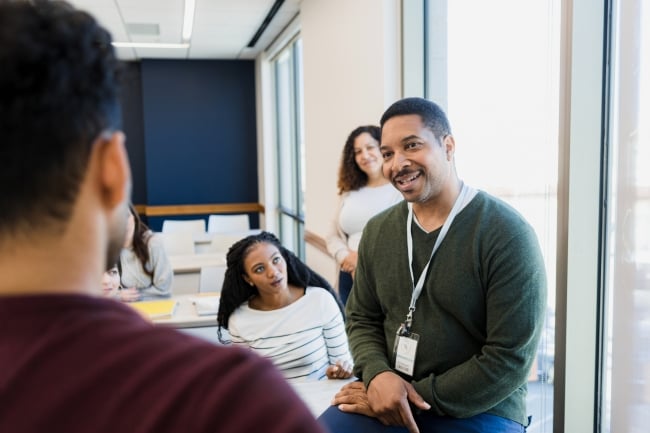You have /5 articles left.
Sign up for a free account or log in.

Faculty members can build trust, belonging and empathy with students by engaging in real talk in the classroom.
SDI Productions/E+/Getty Images
Anaheim, Calif.—A 2024 Student Voice survey by Inside Higher Ed and Generation Lab found 35 percent of college students believe that if their faculty members got to know them, it would increase their academic success.
One initiative at the State University of New York at Oneonta, highlighted at NASPA’s Student Success in Higher Education Conference in Anaheim, Calif., by three faculty members, creates a community of practice among faculty members to encourage them to share their own stories with students.
The program, the Pedagogy of Real Talk, encourages vulnerability, authenticity and empathy in the classroom and in turn invites students to share more of themselves with their faculty and peers.
The background: The term “pedagogy of real talk” (PRT), developed from a book of that title by Paul Hernandez, focuses on creating an inclusive, relevant and engaging course focused on the student experience.
Through this pedagogy, content is reframed to help students see themselves through their own lens and perspectives, called the terministic screen, which aids in their feelings of belonging and connectedness to both the instructor and the institution.
This is accomplished through vulnerability, empathy and compassion and inspires more creative teaching approaches from the instructor as a result.
The pilot: The first cohort of faculty members began working through the curriculum in 2022, with professors Katie Griffes, Kim Fierke and Valerie Rapson in the inaugural crew. Each year, the faculty focus on one of the three pillars of PRT, starting with vulnerability, then empathy and finally compassion.
Faculty participate in a four-day workshop led by Hernandez, monthly cohort support meetings a midyear half-day retreat and other regular meetings and reflection exercises. For their participation and work, faculty receive a stipend from the institution.
Each faculty member commits to leading one “real talk” among their students per term and one alternative lesson, or a lesson that connects course content to the students’ terministic screens.
The real talk is not branded to the student (so a faculty member doesn’t get up and say, “I’m going to give you a real talk”) but rather a facet of a larger lesson. The conversation centers on a universal theme, such as success or frustration, and isn’t painted in a rainbows-and-sunshine light, but often shows a struggle or shortcoming.
For example, Rapson, assistant professor of physical science, starts her algebra-based physics class off with a discussion about her passion for science. It was a curiosity about extraterrestrial life that first led her to astrophysics, but working with young women who were hesitant to study science made her want to be a teacher.
Fierke, an assistant professor of sports management, shares with her students that she was often overlooked as the women’s head basketball coach at a former institution; referees addressed her older male assistant coach first during games.
These conversations highlight a bit of the instructor’s care and passion for their subject and their personal connections to the field, which in turn can inspire similar admissions from students.
Alternative lessons, on the other hand, make learning more personable and directly connected to a student’s daily life or social issues outside the classroom.
Also in her algebra-based physics course (part of the exercise science and sports management majors, often taken by student athletes), Rapson created an assignment for the class to construct their own equation using the sport of their choice. For example, learners calculate the speed or distance of a soccer ball kicked across the field or a javelin thrown. This still teaches them physics, but in a way that is more meaningful to them as a sports fan.
Being real: While the initiative has proven ties to student success practices, real talk can feel uncomfortable to the professor, especially in academic cultures such as STEM fields that focus on knowledge as a professor’s most important characteristic, rather than care.
Not every class is well suited for a real talk, either. Some, like Griffes’s communication courses, naturally lend to personal examples, but other large lectures or STEM courses can be less personal, so working alongside other faculty members to find what works well is key, faculty shared.
Another challenge has been navigating boundary-setting in the classroom in the event students start feeling too comfortable, and making sure faculty members are equipped to refer students to experts on campus who can address any needs that are presented.
The impact: As the pilot is still underway and the cohort enters its third and final year of development, there is yet to be formal assessment data on PRT.
Anecdotally, faculty have noticed students are more likely to drop by their office, stay after class or engage during class to share about their struggles and feelings. In class, students ask more questions and are more excited to show up. Learners also make stronger connections between content and their everyday lives, which further helps with engagement.
The professors have seen PRT apply to their experiences outside their classes as well, both in how they hold themselves in interactions with students around campus, in advising settings or in orientation. Griffes serves as the women’s tennis coach at Oneonta and has found that real talk encourages her team to be vulnerable with one another and set aside their assumptions about themselves.
In the future, faculty members hope to understand how real talk affects students across courses and if the practice builds connection outside of individual courses.
Do you have an academic success tip that might help others encourage student success? Tell us about it.



